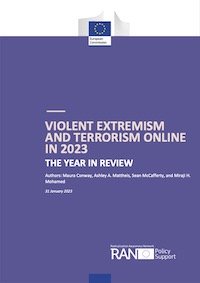By Lisa N. Sacco
The federal government defines domestic terrorism (DT) as ideologically driven crimes committed by individuals in the United States that are intended to intimidate or coerce a civilian population or influence the policy or conduct of a government. Federal definitions of DT are found in the USA PATRIOT Act (18 U.S.C. §2331), the Homeland Security Act (6 U.S.C. §101), and Title 28 of the Code of Federal Regulations (§0.85). Aside from the statutory and regulatory definitions of DT, the Federal Bureau of Investigation (FBI) has historically emphasized particular qualities inherent to the actors who engage in DT. According to the FBI, domestic terrorists are Americans who commit violence to achieve their goals that stem from domestic, extremist ideological influence and lack of foreign direction or influence. This conceptualization excludes ideologically driven crimes committed in the United States by individuals whose actions are directed or motivated by foreign groups. Analyst in Illicit Drugs and Crime Policy How the federal government defines conceptualizes and shapes the nation’s understanding of it as criminal conduct and as a policy issue. Domestic terrorists (and the crimes they commit) are labeled as such because their actions are directed against the civilian population and/or U.S. government within the boundaries of the United States. Like foreign terrorism, domestic terrorism involves ideologically driven criminal acts aimed at influencing the government or coercing the population. Unlike foreign terrorism, the federal government does not have a mechanism to formally charge an individual with DT, which sometimes makes it difficult (and occasionally controversial) to formally characterize someone as a domestic terrorist. Further, domestic terrorists may adhere to the ideologies of certain extremist movements or belong to hate or extremist groups, but unlike the formal process involved in designating foreign terrorist organizations, DT movements and groups are not officially labeled as such by the federal government, thereby making it difficult to categorize the threat presented by any group or movement as a DT threat. While some observers may look to terrorism-related incidents, investigations, and arrests to help understand the scope of the DT threat, these data are limited. DT incidents have a low occurrence rate but a high impact, and the federal government has a significant role in combatting the threat of DT. In 2021, the FBI and the Department of Homeland Security (DHS) issued the nation’s first national strategy for countering the DT threat. The strategy identifies DT threats to include potentially unlawful use or threats of force or violence in furtherance of ideological agendas from racially or ethnically motivated violent extremists, anti-government or anti-authority violent extremists (further broken down to include militia violent extremists, anarchist violent extremists, and sovereign citizen violent extremists), animal rights/environmental violent extremists, and abortion-related violent extremists. How the government defines and combats DT and extremism is complicated for many reasons. Believing in or expressing extremist ideals and/or vocalizing support for DT incidents are not violations of federal law. If an individual in the United States espouses extremist beliefs, such as anarchy or the superiority of the white race, that behavior is generally protected speech under the First Amendment. Expressions of these beliefs sometimes precede DT incidents, and in hindsight, some may question why these incidents could not be prevented. Crossing the line from First Amendment-protected activity, such as a peaceful protest, to DT-related violence can happen quickly; however, there is often little law enforcement can do in response to extremist but protected speech. Despite the statutory definition of DT in Title 18 of the U.S. Code, no federal criminal provision expressly prohibits “domestic terrorism.” While DT is defined in federal statute, the term domestic terrorist is not used to officially label any group (as it is with foreign terrorist organizations). However, federal law enforcement has referred (in some instances such as congressional testimony) to individuals as domestic terrorists and their crimes as DT. Going forward, Congress may consider any number of legislative options regarding the federal government’s approach to defining and confronting DT, including (1) enactment of a DT charging statute; (2) the utility and consequences of applying the DT label in federal policy; (3) allocation of additional, less, or equivalent appropriations to address DT; and (4) adjustments to DT data collection requirements for federal agencies.
Washington DC: Congressional Research Service, 2023. 27p.





















